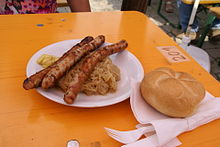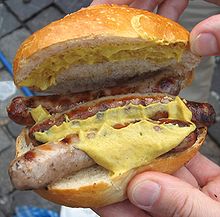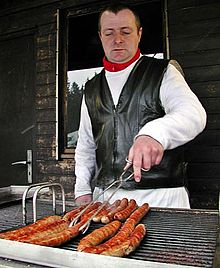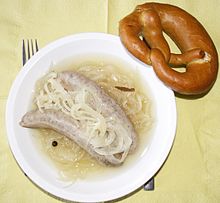- Bratwurst
-
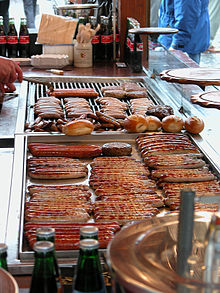 Variety of Bratwürste on a stall at the Hauptmarkt in Nuremberg
Variety of Bratwürste on a stall at the Hauptmarkt in Nuremberg
A bratwurst (German: Bratwurst [ˈbʁaːtvʊɐ̯st] (
 listen)) is a sausage usually composed of veal, pork or beef. The plural in German is Bratwürste.
listen)) is a sausage usually composed of veal, pork or beef. The plural in German is Bratwürste.The name is German, derived from Old High German Brätwurst, from brät-, which is finely chopped meat and Wurst, or sausage. Though the brat in bratwurst described the way the sausages are made, nowadays Germans associate it with German verb “braten”, which means to pan fry or roast.[1] Bratwurst is usually grilled or pan fried, and sometimes cooked in broth or beer.
Contents
History
The first documented evidence of the Bratwurst in Germany dates back to 1313, and can be found in the Franconian city of Nuremberg,[2] which is still an internationally renowned centre for the production of grill sausages.
Types and traditions
Germany
 Nürnberger Bratwurst with sauerkraut and mustard, as served in the Nürnberger Bratwurst Glöckl in Munich
Nürnberger Bratwurst with sauerkraut and mustard, as served in the Nürnberger Bratwurst Glöckl in Munich
Recipes for the sausage vary by region and even locality; some sources list over 40 different varieties of German bratwurst,[3][4] many of the best known originating in Franconia (today for the most part situated in northern Bavaria, but still culturally quite distinct), its northern neighbour Thuringia and adjacent areas. How the sausages are served is also locally different, but most commonly they are regarded as a snack served with or in a Brötchen (white bread roll made from wheat flour) and eaten with hot German mustard. As a pub dish, it is often accompanied by sauerkraut or potato salad and sometimes served with dark, crusty country bread made predominantly from rye flour, less commonly with a Brezel. It is a very popular form of fast food in German-speaking countries, often cooked and sold by street vendors from small stands.
Franconian varieties
Fränkische Bratwurst
The Franconian sausage is a relatively long (10–20cm), thick, coarse sausage, common to the whole Franconian region with slight variations. It dates back to 1573. With marjoram as a characteristic ingredient, it is close in taste to the Nürnberger Bratwurst but juicier, due to its size and coarseness. The Fränkische Bratwurst is traditionally served with sauerkraut or potato salad, but with no mustard — although many customers disregard this tradition and demand plenty of it.
Coburger Bratwurst
Bratwurst originating in the city of Coburg in Franconia was first documented there in 1498.[5] It is made from a minimum of 15% veal or beef, and its seasonings include only salt, pepper, nutmeg, and lemon zest. It is coarse in texture and measures about 25cm in length. Traditionally, it is grilled over pinecones and served in a bread roll (Brötchen).
Kulmbacher Bratwurst
The Kulmbacher Bratwurst, from the city of Kulmbach in Franconia, made mainly from finely ground veal, is long and thin.
Nürnberger Rostbratwurst
The small, thin bratwurst from Franconia's largest city, Nuremberg, was first documented in 1313; it is surprisingly small, being only 7 to 9cm in length and weighing between 20 and 25 g. Perhaps the most popular sausage in Germany, the denominations Nürnberger Bratwurst and Nürnberger Rostbratwurst (Rost refers to the cooking grate above the flames) are Protected Geographical Indications (PGI) under EU law since 2003,[6] and may therefore only be produced in the city of Nürnberg, where an "Association for the Protection of Nürnberger Bratwürste" was established in 1997.[7]
Pork-based and typically seasoned with fresh marjoram which gives them their distinctive flavour, these sausages are traditionally grilled over a beechwood fire. As a main dish, they are served in sets of six, eight, 10 or 12 on a pewter plate (round but also frequently heart- or bell-shaped) with either sauerkraut or potato salad, and accompanied by a dollop of horseradish or mustard. They are also sold as a snack by street vendors as Drei im Weckla (three in a bun; the spelling Drei im Weggla is also common, Weggla/Weckla being the Nuremberg slang for Brötchen), with mustard being offered to spice them up to personal taste.
A particular way of preparing Nuremberg sausages without grilling them is to cook them in a spiced vinegar and onion stock; this variety is called Blaue Zipfel (blue lobes).
Würzburger Bratwurst
The Würzburger Bratwurst, also known as the Winzerbratwurst, comes from the city of Würzburg in Franconia. Its size is similar to the Thüringer Rostbratwurst, but its ingredients include white Franken-Wine.
Other varieties
Thüringer Rostbratwurst
Main article: Thuringian sausageThe Thüringer Rostbratwurst is a spicy sausage from Thuringia. It is 15–20cm long and thin in shape, traditionally grilled over a charcoal fire and eaten with mustard and bread. The name Thüringer Rostbratwurst is also recognised as a PGI under EU law.
Triggered by the discovery in 2000 of an account entry of 1404 first mentioning the Bratwurst in Thuringia in the town of Arnstadt, the association "Friends of the Thuringian Bratwurst" was founded in 2006. In the same year, the association established the Erste Deutsches Bratwurstmuseum (First German Bratwurst Museum) in the village of Holzhausen. A two-metre-high wooden monument of a Bratwurst in a bun on a local traffic roundabout advertises the museum.[8]
Nordhessische Bratwurst
The Nordhessische Bratwurst (from northern Hessen) is similar to the Thüringer Rostbratwurst in taste. It is made from coarsely ground pork and is heavily seasoned. It measures around 20cm in length. Traditionally, it is grilled over a wood fire and served on a cut-open roll with mustard.
Rote Wurst
The Rote Wurst (red sausage) is a favorite Bratwurst of the Swabian region. It is similar to the Bockwurst, and is made from finely ground pork and bacon. Its taste is spicy. To prevent splitting during grilling or pan frying, an X is cut into the ends of the sausage. The ends open during cooking, but the rest of the sausage remains intact, giving it its traditional shape.
United States
Bratwurst is a common type of sausage in the United States, especially in the state of Wisconsin, where the largest ancestry group is German.[9] Originally brought to North America by German immigrants, it is a common sight at summer cookouts, alongside the more famous hot dog. Wisconsin is also the origin of the "beer brat", a regional favorite where the bratwurst are poached in beer (generally a mixture of a pilsner style beer with butter and onions) prior to grilling over charcoal.
The bratwurst was popularized in Sheboygan County, Wisconsin in the 1920s. In general, each local butcher shop would take orders and hand make bratwurst fresh to be picked up on a particular day. The fat content of the sausages was substantial, making daily pick up necessary to avoid spoilage. Much of the fat was removed during the cooking over charcoal. Usually one kept a pan of cold water handy to the grill, so it was easy to dip one's fingers in and fling the water onto the flames caused by the burning of the excess fat.
The bratwurst (or "brat") also became popular as a mainstay of sports stadiums after Bill Sperling introduced bratwurst to Major League Baseball in Milwaukee County Stadium in 1953. The bratwurst were such a hit, Sperling said, that Duke Snider of the Brooklyn Dodgers took a case back to New York.[10] Currently Miller Park in Milwaukee, Wisconsin is the only baseball stadium that sells more bratwurst than hot dogs.
The town of Bucyrus, Ohio (known as the "Bratwurst Capital of America") has held the three-day Bucyrus Bratwurst Festival annually since 1967.[11][12]
See also
- Bockwurst
- Sausage Race
- Blood sausage
- Wurst mart
- Knackwurst
- Sausage
- Hot dog
- List of sandwiches
References
- ^ "LEO Deutsch-Englisch Wörterbuch". http://dict.leo.org/ende?lp=ende&search=braten. Retrieved 2009-04-09.
- ^ Bavarian Department for Food, Agriculture and Forestry
- ^ German Food Guide
- ^ Whitlock, Craig (2007-12-02). "Germans Take Pride in the Wurst". The Washington Post.
- ^ 1. Deutsches Bratwurstmuseum — History of the Bratwurst
- ^ "Commission of the European Commission Regulation (EC) No 1257/2003". http://eur-lex.europa.eu/LexUriServ/LexUriServ.do?uri=CELEX:32003R1257:EN:NOT. Retrieved 2009-04-18.
- ^ Schutzverband Nürnberger Bratwürste e.V.
- ^ For more information consult the museum's website (in German but with an automatic translation option)
- ^ "Ancestry: 2000," U.S. Census Bureau
- ^ madison.com
- ^ Fenton, Laura (August 19, 2005). "What!? I can get this stuff for how much?". Today at msnbc. http://www.msnbc.msn.com/id/9005587. Retrieved 2009-10-28.
- ^ "Discover Ohio". Ohio Department of Development, Division of Tourism. http://consumer.discoverohio.com. Retrieved 2011-2-12.
External links
Categories:- German cuisine
- German sausages
- American sausages
- Wisconsin culture
- German loanwords
- Sandwiches
- Veal dishes
Wikimedia Foundation. 2010.

